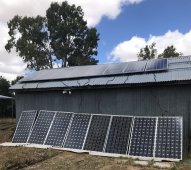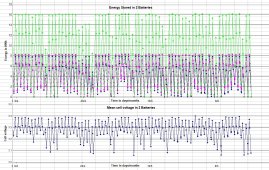mcart117
New Member
- Joined
- Mar 28, 2022
- Messages
- 121
In the context of my last post, this has become quite an interesting chart; at least for me it has.

EVE in their product specs state that the maximum voltage for these LFP cells is 3.65V and the minimum voltage is 2.5V. They also say you can extend the life of the cells by limiting the depth of discharge (DoD) to 80%.
I used charts published by the OFG to estimate the voltages associated with an 80% DoD. Essentially I followed the discharge curve to just before the inflection point to gauge my cell under voltage setting and the charging curve to just before its inflection point for guidance on my cell over voltage setting. I didn’t create my own curves because I don’t think these stress tests are good for the cells and I didn’t see any need to replicate the work of others.
Besides, I can tell from my own live working data, if I get it slightly wrong, because one or more runners will appear if I get too close to the inflection points. For example I originally set my cell over voltage to 3.45V, but one cell started running close to 50 mV ahead of the rest, so I reduced the cell over voltage to 3.425V. I also reduced the threshold for balancing from 3.4V to 3.3V on a difference of 10mV.
On the chart above, the orange lines represent the EVE max and min voltages, and the yellow lines represent my own cell over and under voltage levels. And you can see from 4 weeks of data the cell voltages have mostly remained well within that range.
According to the OFG video and other posts, that should give me an 80% DoD, which on 16 cells with a nominal capacity of 1KWh each should give a usable capacity of 12.8 KWh. But you can see from the chart, my actual usable capacity is getting very close to the nominal capacity of 16KWh. Of course the figures come from the BMSs and they could be wrong. But I don’t think they are, because the battery is easily running for 15 hours a night now, from 4:30 p.m. to 7:30 a.m., and the capacity figures are consistent with our measured usage over that period.
I should add that I sourced these cells from Amy Wan of Shenzhen Luyuan, and I am pretty pleased with them so far.

EVE in their product specs state that the maximum voltage for these LFP cells is 3.65V and the minimum voltage is 2.5V. They also say you can extend the life of the cells by limiting the depth of discharge (DoD) to 80%.
I used charts published by the OFG to estimate the voltages associated with an 80% DoD. Essentially I followed the discharge curve to just before the inflection point to gauge my cell under voltage setting and the charging curve to just before its inflection point for guidance on my cell over voltage setting. I didn’t create my own curves because I don’t think these stress tests are good for the cells and I didn’t see any need to replicate the work of others.
Besides, I can tell from my own live working data, if I get it slightly wrong, because one or more runners will appear if I get too close to the inflection points. For example I originally set my cell over voltage to 3.45V, but one cell started running close to 50 mV ahead of the rest, so I reduced the cell over voltage to 3.425V. I also reduced the threshold for balancing from 3.4V to 3.3V on a difference of 10mV.
On the chart above, the orange lines represent the EVE max and min voltages, and the yellow lines represent my own cell over and under voltage levels. And you can see from 4 weeks of data the cell voltages have mostly remained well within that range.
According to the OFG video and other posts, that should give me an 80% DoD, which on 16 cells with a nominal capacity of 1KWh each should give a usable capacity of 12.8 KWh. But you can see from the chart, my actual usable capacity is getting very close to the nominal capacity of 16KWh. Of course the figures come from the BMSs and they could be wrong. But I don’t think they are, because the battery is easily running for 15 hours a night now, from 4:30 p.m. to 7:30 a.m., and the capacity figures are consistent with our measured usage over that period.
I should add that I sourced these cells from Amy Wan of Shenzhen Luyuan, and I am pretty pleased with them so far.





